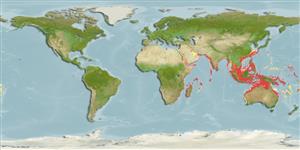Common names from other countries
Environment: milieu / climate zone / depth range / distribution range
Ökologie
seewasser riff-verbunden; tiefenbereich 20 - 140 m (Ref. 58302). Deep-water; 30°N - 36°S, 22°E - 154°W
Indo-West Pacific: Red Sea and the Persian Gulf eastward to Sri Lanka; then from India to the Philippines and Oahu, Hawaii, north to the Ryukyu Islands (Ref. 559), south to northern Australia. Recently recorded from Reunion (Ref. 53568).
Size / Gewicht / Alter
Maturity: Lm ? range ? - ? cm
Max length : 28.0 cm FL Männchen/unbestimmt; (Ref. 3287)
Adults occur in the continental shelf (Ref. 7300). They form schools in depths from 50 to at least 130 m. They feed on epibenthic crustaceans and cephalopods (Ref. 37816). Maximum depth reported taken from Ref. 9773.
Life cycle and mating behavior
Maturities | Fortpflanzung | Spawnings | Egg(s) | Fecundities | Larven
Paxton, J.R., D.F. Hoese, G.R. Allen and J.E. Hanley, 1989. Pisces. Petromyzontidae to Carangidae. Zoological Catalogue of Australia, Vol. 7. Australian Government Publishing Service, Canberra, 665 p. (Ref. 7300)
IUCN Rote Liste Status (Ref. 130435)
CITES (Ref. 128078)
Not Evaluated
Bedrohung für Menschen
Harmless
Nutzung durch Menschen
Fischereien: weniger kommerziell
Tools
Zusatzinformationen
Download XML
Internet Quellen
Estimates based on models
Preferred temperature (Ref.
115969): 22.9 - 28.3, mean 27.2 (based on 781 cells).
Phylogenetic diversity index (Ref.
82804): PD
50 = 0.6250 [Uniqueness, from 0.5 = low to 2.0 = high].
Bayesian length-weight: a=0.01349 (0.00646 - 0.02815), b=2.96 (2.79 - 3.13), in cm Total Length, based on LWR estimates for this (Sub)family-body shape (Ref.
93245).
Trophic level (Ref.
69278): 4.1 ±0.48 se; based on food items.
Widerstandsfähigkeit (Ref.
120179): hoch, Verdopplung der Population dauert weniger als 15 Monate. (Preliminary K or Fecundity.).
Fishing Vulnerability (Ref.
59153): Low vulnerability (21 of 100).
